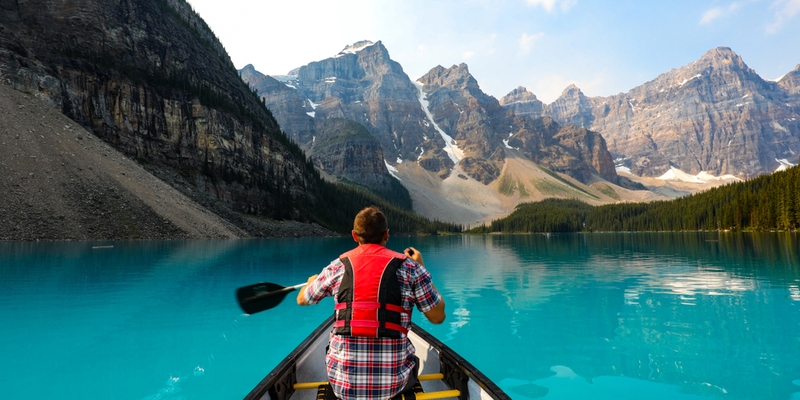
If you are not redirected within 30 seconds, please click here to continue.
Samedi: 10h – 16h HAE

If you are not redirected within 30 seconds, please click here to continue.
If you are not redirected within 30 seconds, please click here to continue.
Looking to escape the cold Canadian winters? An annual vacation during winter months to the south might be your calling. And you're not the only one - Statistics Canada reported an estimate of 300,000 to 375,000 Canadian snowbirds in the US and Mexico in 2019.
In this article, we'll walk you through the essentials of snowbird insurance, helping you safeguard your Canadian spirit of adventure.
What is snowbird insurance?
Coined after the actual birds that migrate south every winter, a "snowbird" is a Canadian who escapes the frigid temperatures by heading south to warmer destinations for extended periods of time. Popular snowbird destinations include Florida, Arizona, and Mexico, where sunny skies await.
It's become so popular among retired Canadians that there's a special insurance category for to cater to their specific needs: Snowbird insurance, which offers emergency health and medical protection for seniors on their extended journeys outside of Canada.
Unlike regular travel insurance, which can only provide you with coverage for a limited number of days, snowbird insurance is specifically designed to safeguard you from any unforeseen circumstances for longer periods of time.
Types of snowbird insurance
There are two main types of insurance coverages you can get as a snowbird:
Single trip insurance: Covers one annual fixed trip (up to 183 consecutive days or 212 consecutive days for Ontario and Newfoundland residents) per year. This is a cheaper option but allows less flexibility.
Multi trip insurance: Covers an unlimited number of trips within a given period from when the policy starts. However, there's a limit on how long you can stay in each place — usually around 30-60 days.
"It’s only for the allotted number of days that you bought it for,” says Martin Firestone, travel insurance consultant and president of Toronto-based Travel Secure Inc. “You can travel up to that number of days and either come back home or step back in your home province before you leave again.”
Some snowbird insurance providers offer "top-ups," which let you pay in advance for extra days at the end of your stay. There are plans that let you buy top-ups from your destination, though they are more expensive.
What snowbird insurance covers
Like other types of travel insurance, there’s no one-shoe-fits-all snowbird insurance plan -- your policies and premiums will be tailored to your needs.
In the event of a medical emergency, snowbird insurance will provide coverage for:
- Hospitalization expenses: Your policy will cover the costs associated with hospital stays.
- Ambulance fees: Transportation to medical facilities is included within your coverage.
- Medical equipment: Necessary equipment and supplies are provided as part of your insurance.
- Medical treatments: This encompasses various treatments, including surgical procedures and emergency dental care.
- Prescription drugs: Expenses for prescription medications are taken care of.
- Emergency repatriation: In dire situations, your insurance ensures emergency transportation back to Canada for treatment and care.
Depending on how extensive your coverage is, there are add-ons available:
- Trip cancellation: Comes in handy with non-refundable tickets, missed reservations, non-refundable excursions, tour expenses, cancellation fees if caused by reasons beyond your control.
- Lost or stolen baggage: You’ll be covered with any costs associated with a lost, delayed or stolen bag during your trip.
A common mistake when getting trip cancellation insurance is waiting until you know something might go wrong. “If you already know about a problem, like a hurricane being announced in a travel advisory, it's too late to buy the insurance to cover non-refundable trip expenses,” cautions Firestone.
Related: Travel advisories and travel insurance: what to know about your coverage
Your snowbird insurance won’t cover any cosmetic surgery, dental work (unless caused in an accident), routine checkups with a family doctor, or any elective medical procedures.
How to qualify for snowbird insurance
To qualify as a snowbird for travel insurance, you must be:
- at least 60 years old.
- a Canadian citizen or permanent resident.
- travelling outside of your home province or territory for a period of 90 to 212 consecutive days.
Health risks assessment
Considering snowbird insurance caters to senior travelers, most insurance providers will require you to fill out a detailed medical questionnaire where your health risk conditions will factor into your insurance premium.
“An incorrect answer to the questions could be crucial at claim time for something totally unrelated to that problem,” says Firestone. For instance, if you’re currently not experiencing high blood pressure but are taking preventive medication for it, it’s essential to disclose this information. It might have implications for a separate health issue.
Minimum stability period
Some insurers also have a “minimum stability period” which confirms that any pre-existing medical condition you may have has stable for a given period of time before you can be insured. The minimum stability period is usually 90, 120 or 180 days in which your condition, if any, cannot worsen, cause any new symptoms, or require new prescriptions or treatment plans.
For individuals who don’t meet the minimum stability period but still wish to travel, considering a personalized travel medical insurance plan may be worthwhile. Although uncommon, such plans may be available from select insurance providers.
Note: There isn’t a stability requirement for pre-existing medical conditions for travel within Canada plans.
Read more: Get the right travel insurance even with a pre-existing medical condition
How much does snowbird insurance cost?
Your insurance cost is determined by your premiums. Typically, the more coverage you have, the costlier your insurance will be.
Several factors can influence how much you'll pay for your snowbird insurance:
Your age: Typically, younger individuals are considered lower risk and may pay lower premiums, while older individuals may face higher costs due to increased health-related risks associated with aging.
Trip duration: The length of your stay abroad plays a role in determining your premium. Longer trips often mean a higher premium since there's a greater chance of needing medical care or encountering unforeseen events.
Pre-existing medical conditions: If you have pre-existing medical conditions, insurers may charge higher premiums to account for the potential need for medical treatment while you're away.
Deductible amount: Your deductible is the amount you agree to pay out of pocket before your insurance coverage kicks in. Opting for a higher deductible can reduce your premium but means you'll need to cover more expenses if you make a claim.
Destination: Some insurers may adjust rates for destinations in the United States. This adjustment accounts for the higher costs of healthcare in the U.S., which can affect the overall risk and cost associated with insuring travelers heading there.
Comparing snowbird insurance rates will help you find the best rate that works for your unique needs.
Tips on how to handle snowbird insurance claims
Handling snowbird insurance claims effectively is crucial to ensure you receive the coverage you need during your extended stay abroad. Here are some tips to help you navigate the claims process smoothly:
Contact your insurer promptly: As soon as you encounter a situation that might require a claim, get in touch with your insurance provider. Most policies have specific timeframes for reporting incidents, so it's essential to act quickly.
Keep records: Document all relevant information regarding the incident, including dates, times, locations, and any communication with healthcare providers. Take photos if applicable, and retain receipts for medical expenses, prescriptions, or other costs related to the claim.
Keep a copy of your policy: Carry a copy of your insurance policy with you during your trips. It will serve as a quick reference guide if you need to review coverage details or contact information for your insurer.
Seek authorization for medical procedures: Before undergoing any non-emergency medical procedures, contact your insurer for authorization. Failure to obtain prior approval might result in claim denial.
Hold on to small claims: If you have small claims or top-ups you bought for your trip that went unused, hold on to them and submit them upon return to get it refunded.
How to prepare for your snowbird adventure
Review your insurance coverage: Double check your existing car insurance to ensure it covers your vehicle while it's parked during your snowbird trip. Likewise, assess your home insurance to protect your property during your absence.
Insure your valuables and possessions: Safeguard your valuable possessions by either taking them with you or placing them in secure storage. Ensure your insurance covers any valuable items left at home.
Go over your credit card insurance: Understand the terms and limitations of this coverage and supplement it as needed with additional policies. Remember, your coverage only applies to purchases booked on the specific insured credit card.
In the world of snowbird insurance, preparation is the key to peace of mind. Understanding how it works, choosing the right coverage, and being vigilant about your health and safety during extended stays abroad ensures you can fully enjoy your winter escape. Safe travels!
Read next: Thinking of spending winter abroad? 9 questions for a newbie snowbird
Your passport to stress-free travel
Make sure you are prepared for anything by comparing travel quotes and finding the best rates for the coverage you need before leaving home!
Get money-saving tips in your inbox.
Stay on top of personal finance tips from our money experts!











